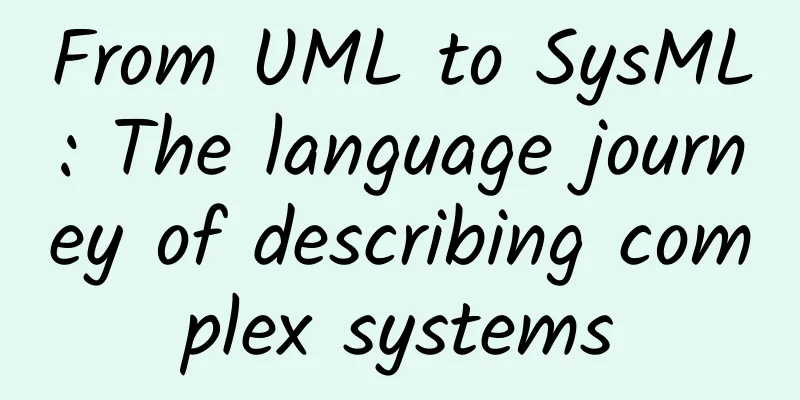From UML to SysML: The language journey of describing complex systems

|
In the vast world of systems engineering, which language can help engineers accurately describe complex systems, capture requirements, and design solutions? The answer is SysML (Systems Modeling Language) - a modeling language tailored for systems engineering. SysML is not only a collection of technologies, but also a historical accumulation. Its development process is full of transformation and innovation. Let's take a journey through time to explore the development history of SysML and how it has become a powerful assistant for system engineers. Preface: The birth of a new languageBack in the early 2000s, the International Council of Systems Engineers (INCOSE) and the Object Management Group (OMG) found that despite the popularity and widespread use of the Unified Modeling Language (UML), it was not expressive enough when dealing with complex system projects. Engineers needed a language that was better suited to describing non-software elements such as hardware and people. Thus, SysML was born, which extends UML to specifically meet the needs of complex system projects. Chapter 1: The evolution of languageThe first official version of SysML was released in 2006. This version focuses on the modeling capabilities of complex systems, including hardware, software, data, people and processes. SysML was designed from the beginning as a simplified but powerful language that reduces some of the complexity of UML to make it more focused on the needs of system engineering. Chapter 2: Exploring the Core FeaturesThe charm of SysML lies in its diversity and flexibility. It includes the following core diagrams:
Chapter 3: Wide range of application scenariosWhether it is airplanes in the sky, cars on the ground, or medical equipment in hospitals, SysML is used almost everywhere. It helps engineers design safer aerospace equipment, develop more efficient cars, and even plays an irreplaceable role in the fields of national defense and public safety. Conclusion: The power of languageSysML is not just a collection of diagrams and symbols, it is a bridge for engineers to communicate with complex systems. Through this unique language, teams can communicate ideas more accurately and collaborate more efficiently. The history and development of SysML not only demonstrates the progress of technology, but also the expectation of unlimited possibilities in the future. SysML will continue to be an indispensable partner on the road to exploring and designing the future world. |
<<: Daily Bug Troubleshooting-All Connections Suddenly Closed
>>: The future of optical communications: innovation and integration of PON technology
Recommend
5G: A game changer on the factory floor
Driven by the Internet of Things, global manufact...
Aruba Launches First-Ever Asset Tracking Solution to Improve Workforce Efficiency and Customer Experience at a Low Cost
The solution uses new Bluetooth Low Energy (BLE) ...
Research and application of 3D-MIMO antenna weight optimization method based on MDT
Labs Guide This paper proposes a method to optimi...
Understanding Deterministic Networks in Seconds: Playing with Queues (Part 2)
The previous section introduced the evolution of ...
HostYun: Hong Kong high bandwidth VPS monthly payment starts from 18 yuan, South Korea VPS monthly payment starts from 16 yuan, Japan/Russia/Los Angeles Cera monthly payment starts from 19 yuan
Let me recommend HostYun, a long-established low-...
The Ministry of Industry and Information Technology's Radio Frequency Administration conducts a survey on 5G dedicated frequency demand
According to information from the official websit...
Hengchuang Technology 618 special offer, cloud server as low as 28% off, US/Japan/Hong Kong CN2 line annual payment starts from 296 yuan
Hengchuang Technology has released this year'...
What does it feel like to immerse yourself in 50 industry scenes in a 7,000-square-meter exhibition hall?
[51CTO.com original article] From March 9 to 10, ...
Site24x7 enters China's cloud monitoring market and opens Shanghai data center
On March 12, 2019, Zoho Corporation announced the...
RAKsmart: Dedicated servers starting at $30/month, 1-10Gbps bandwidth, unlimited traffic available
RAKsmart's year-end promotion is in full swin...
Is China going to build its own Internet root server?
[[269137]] On June 26, an article titled "Th...
Will the 5G market usher in changes? Private 5G discounts surpass the three major operators
In addition to the rapid development and wide cov...
How do two computers in different places send data to each other? How many people are discouraged by the five-layer model?
Today's article is the opening. In fact, I ha...
DogYun (狗云) Mid-Autumn Festival 21% off, top up 710 yuan to get 71 yuan, lucky big wheel draw 50% off
DogYun is a Chinese hosting company that provides...
Hyperscale Data Centers vs Micro Data Centers
Some say the data center of the future is very di...









